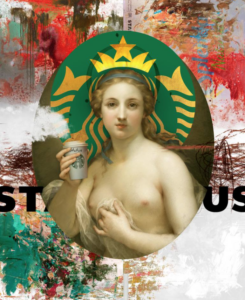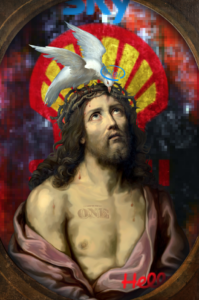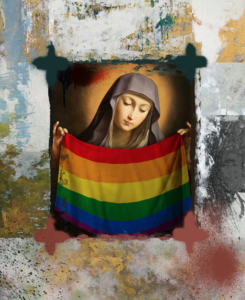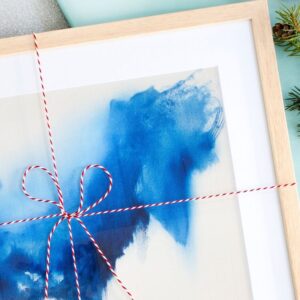NFTs
 José Luis Guerrero
José Luis Guerrero
José Luis Guerrero is a Mexican artist with a degree in advertising from the Escuela de Artes Plásticas (School of Visual Arts) at the University of Guadalajara. His collage style patches together elements from various historical contexts to create a new connotation altogether. In his words, Guerrero’s intention is to “gather two known ideas to get a new one” through his work. We were privileged to have him with us on his project and would love to hear his insight on his experience.

Hi José, what a pleasure to have you join us in The Other Avatars. Can you tell us a little about yourself before we dive deeper?
Hello Laura, I’m José Luis Guerrero. I was born in Mexico, in the state of Jalisco, and I still live here. Most of the times I work with collage techniques, dismembering images, logos, and all kinds of graphics to transform them into new pieces with very different meanings.

When did you first start creating art and how did that evolve into becoming a professional artist?
It’s hard to think of a specific moment in which I started creating art. I have always had memories of drawing, but I do remember that around the time I was 10 I had the opportunity to make oil painting for the first time and I loved it.
When it was time for me to start college, I initially wanted to study painting techniques, but I ended up enrolled in an advertising career. Once I graduated, I worked as a graphic designer and continued drawing and developing graphic concepts and illustrations for specific clients. With the constant technological advancements and new media, I wanted to return to the good path of just making art for my own joy. I was excited to apply my media and advertising knowledge into my art pieces using digital tools.
That’s a bold choice to reclaim your own terms for making art. What does your artistic practice look like today? Can you tell us a bit about the mediums you work in?
I mainly do digital compositions. I still draw and I still do oil painting and all of those techniques have their own charm. However, I like digital mediums better because I can see a complete result sooner and editing is way easier.
How do you approach your work?
I really like to let my work flow unconsciously. I usually take inspiration in art magazines or I browse the internet looking for images, admiring pieces made by other artists. Also, walking my dog Momo helps to get inspiration: while walking with him ideas flow, pieces come together in my head, shapes, objects, symbols, signs, and logos start to feel compatible for me to create a new piece.
There is inspiration in everything! Each thing, each element, has lots of information that anyone can use: an apple can mean death, sins, Magritte. It can even make us think of an expensive computer, or a bite, or rottenness. It’s still just an apple but it can have very different meanings depending on the context we give to it. I believe that I’m able to find inspiration everywhere because everything contains information.

What interests you about NFTs and why did you choose to be involved in this project?
NFTs interest me because they expand the art market. It’s a way of reaching more people, new generations, new ways of understanding art. I started doing some research because I didn’t know anything about it. I only knew that some NFTs were sold for an incredible amount of money, that Banksy had done something about NFTs on his social networks, and that some celebrities were doing their own.
I decided to accept Saatchi’s kind invitation to the Other Avatars project because of multiple reasons. Mainly, it’s a great opportunity to see my own work alongside the art of various colleagues from around the world. At first, I was very excited for the creative and artistic bits of the Other Avatars project, but my fear of ignoring how everything else around NFTs worked made me begin the journey with maniac research. To be honest, I got a little scared after reading about the process of putting them up for sale but I still wanted to get involved in the project as much as possible because it seems like a good opportunity to learn new things and meet new people.
How did the experience compare with what you’d initially expected? I’d be interested to know how your personal style and approach to your art was affected by the subject and conditions of this project.
On the technical side, this project matches a lot with my artistic style, which is the collage, however I didn’t know that sticking to the use of certain elements was going to be a challenge for me. At first, I jumped into this project as if it was a client request and I was very determined to incorporate a specific number of elements in very organized ways. Then, I started seeing the avatars as a general concept of “characters” and ended up having a lot of fun and wanting to continue doing more avatars. When I relaxed and loosened up a bit, it turned out to be a pleasant and comfortable artistic experience. I just missed doing more controversial pieces and being critical through them, but I’m glad that I took this chance to create art that can show beauty and that is fun and pleasing to look at.
What was the most enjoyable part of the project?
Being able to see the pieces as a complete set. I rarely work on series, so I loved seeing the finished ensemble. The daily process of characterizing Van Gogh also amused me a lot, although I don’t know if he would’ve liked it!
What was the most challenging part of the creation process?
Time management! To me, time’s always a challenge. Being able to polish and to go over the pieces, to distance myself from them and to observe them from different perspectives often leads to a huge need for more time.
Speaking of Van Gogh, what do you think he would have thought about NFTs?
I think that Van Gogh would have ventured into the creation of NFTs, maybe he would’ve even invented new ways of making them. Probably that would’ve helped him to save his ear or his mind!
Maybe so! Van Gogh was very productive during his year-long stay in a secluded mental asylum, creating over 150 paintings. With the pandemic keeping many of us socially isolated, home-bound, and anxious, do you think modern artists can relate to or draw inspiration from Van Gogh? And is there any advice you would like to give artists who are considering creating NFTs?
Yes! Confinement plus leisure is a bad combo. Taking advantage of our free time creating art not only can make us as productive as Van Gogh was, but it can also be therapeutic. Most of the time, we release our inner monsters through art. The passion with which Van Gogh lived is inspiring on its own, we just have to be careful not to let that passion overwhelm us. We must finish this long-lasting confinement in one piece because it’s hard to enjoy art if we are torn apart.
And to new artists, I would say that in my experience, creating NFTs has been a very pleasant road to travel. This might be the future of art or at least an extension of it, so it’s a must for artists to know about them and even to create some. I can also tell new artists that in my opinion, creating an NFT manually is more meritorious than an NFT generated by Artificial Intelligence. This way of making digital art requires the same amount of time to conceptualize that any other analogous piece.
Is there anything you would want collectors to know about your work? Or The Other Avatars?
That there are many neurons burnt on it!
Jokes aside, they are the ones who make it possible for artists to enjoy creating because there’s nothing more gratifying than the fact that someone who doesn’t know much about me showing off my work in one of their walls or digital spaces. I’m very grateful to them for helping me continue doing what I like. I also want the collectors to know that Other Avatars is a gigantic project in which so many people have worked on passionately. Please appreciate all the time, energy, and joy we’ve poured into this project as an artistic community.
Love reading about all things art? You can have articles from Canvas, curated collections, and stories about emerging artists delivered straight to your inbox. Sign up for the Saatchi Art Newsletter.






